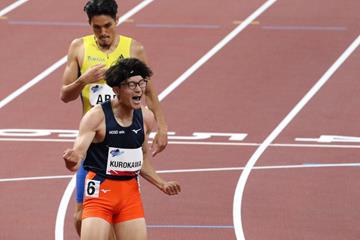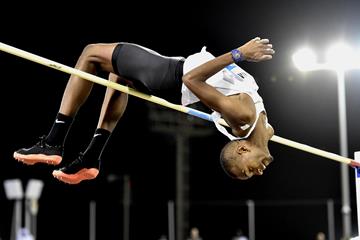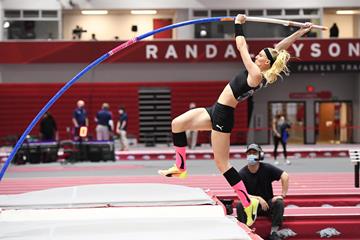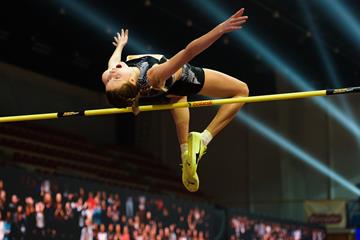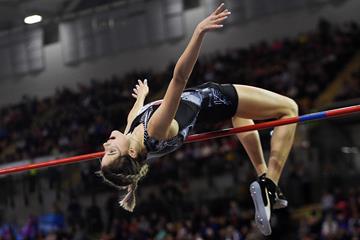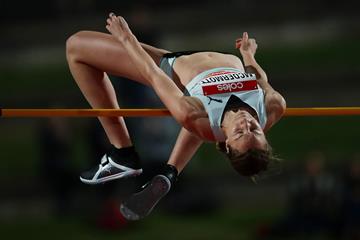 Countdown
Countdown
 Countdown
Countdown
The high jump is a track and field event in which competitors leap (unaided) from one foot over a four-metre-long horizontal bar. Athletes accelerate down the runway, take off on one foot and aim to clear the greatest height without knocking the bar to the ground. Once they’ve completed their jump, athletes land on a crash mat.
High jump contests were popularised in Scotland during the early 1800s
Men’s high jump made its Olympic debut at the 1896 Games
Women’s high jump was introduced to the Olympic programme in 1928
The event has seen radical changes in technique over the years, with former methods such as the eastern cut-off, western roll and the straddle no longer in use
The Fosbury flop technique, made popular by the 1968 Olympic champion Dick Fosbury, is now almost exclusively used by elite high jumpers
The first women’s high jump world record was set by Nancy Voorhees (United States), when she successfully cleared 1.46m in 1922. Three years later, Phyllis Green (Great Britain) was the first woman to exceed 1.50m (1.524m in 1925).
Women’s records progressed steadily over the years, with European high jumpers leading the way. Two Dutch athletes achieved the next two milestones: Lien Gisolf with 1.605m (1929) and Fanny Blankers-Koen with 1.71m (1943).
By the late 1950s, Iolanda Balaș had become Romania’s most successful high jumper. Not only did she dominate, she propelled the sport at an unparalleled pace. Balas set 14 world records over a five-year period, increasing her height from 1.75m (1956) to 1.91m (1961).
A few years later, in 1977, Rosemarie Ackermann (Germany), became the first female high jumper to land a jump of 2.00m. Stefka Kostadinova (Bulgaria) cleared 2.09m at the 1987 World Championships in Rome and that remained the world record for 37 years.
In the lead up to the Paris 2024 Olympic Games, Yaroslava Mahuchikh (Ukraine) added a centimetre to the world record, clearing 2.10m at the Diamond League meeting in the French capital. As well as being the world record-holder, Mahuchikh is a world gold medallist indoors and outdoors and she claimed bronze at the Tokyo Olympics.
The first men’s high jump world record was set in 1827. Adam Wilson (Great Britain) achieved a height of 1.575m. A total of 37 records were set during the pre-IAAF period: 26 by Great Britain, eight by the United States and three by Ireland.
The IAAF ratified their first men’s high jump record in 1912. This inaugural record was set by George Horine (United States) with a height of 2.00m.
Initially, the men’s high jump world record progression was slow. But finally, in 1941, Lester Steers (United States) became the first male high jumper to surpass 2.10m (2.11m). The next milestones were achieved by his compatriots John Thomas (2.22m in 1960) and Dwight Stones (2.30m in 1973).
In 1988, Javier Sotomayor of Cuba set a world record of 2.43m and he improved it to 2.44m in 1989. The Cuban great set the current men’s high jump world record of 2.45m in 1993, which made him the first (and still only) man in history to exceed 8ft.
High jump demands speed, explosive power and agility. Each of the top-performing high jump athletes has displayed these qualities in abundance.
Among the most successful Olympians is Iolanda Balas (Romania). To date, Balas is the only high jumper to have claimed two consecutive Olympic gold medals (1960, 1964). She was so dominant that she went unbeaten for 11 years in the event!
Away from the Olympics, Blanka Vlasic (Croatia) was an incomparable high jumper. She claimed four world gold medals in a row: two at the World Championships (2007, 2009) and two at the World Indoor Championships (2008, 2010).
In the men’s event, Javier Sotomayor is regarded as the best high jumper in history. He’s the current world record-holder, the only man to ever clear 8ft and the Olympic gold medallist from the 1992 Games in Barcelona. He’s followed by Mutaz Barshim (Qatar), who won three back-to-back world titles (2017, 2019, 2022). Barshim and Italy’s Gianmarco Tamberi made history at the Tokyo Olympics when they both cleared 2.37m and couldn’t be separated on countback. They decided to share the title.
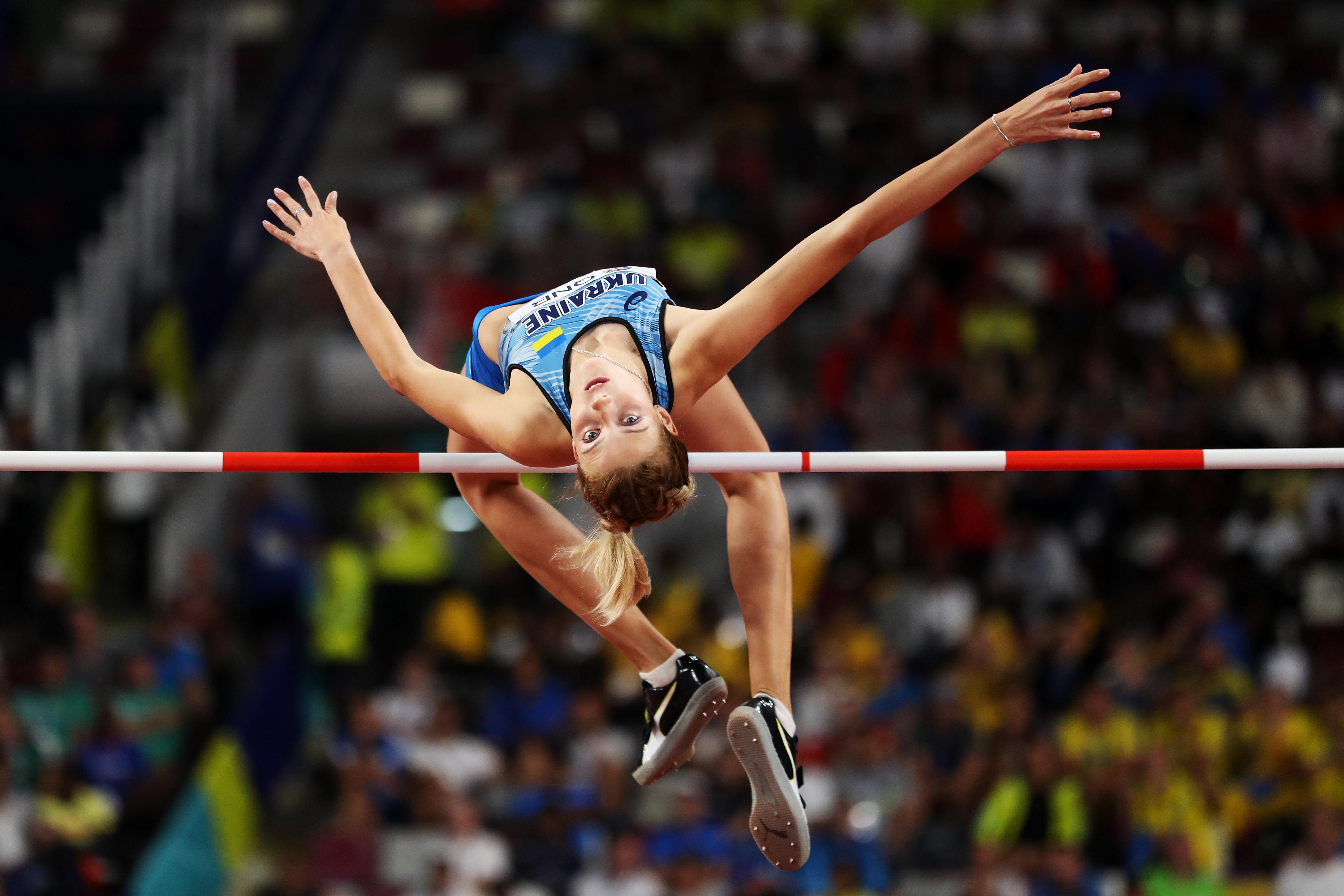
The high jump can involve a range of different techniques, from the western roll to the Fosbury flop. Regardless of which technique an athlete uses, each competitor follows the same four steps of high jump:
Approach
Take-off
Flight
Landing
The most common approach is the J-shaped run-up. This J-shape allows the competitor to generate maximum speed and momentum while optimally positioning themselves for take-off. Other popular approaches include the (wider) flared approach and the (narrower) hook approach.
Next, the athlete completes take-off. They push away from the ground with their take-off foot and create lift by driving their opposite knee and arm upwards. The take-off foot should be placed slightly ahead of the body and planted 2-3ft from the bar.
During the flight phase, the jumper’s body follows a curved (parabolic) trajectory over the bar. In the Fosbury flop technique, the jumper’s head and shoulders lead, followed by the arched back and the legs.
After clearing the bar, the athlete lands with their back on the crash mat.
The Fosbury flop, which was popularised by 1968 Olympic champion Dick Fosbury, involves approaching the bar with a curved run. After take-off, the jumper rotates and positions their back towards the bar. They arch their body and travel over the bar head first. Once clear of the bar, the athlete extends their body before landing.
The scissors technique involves a straight approach. The jumper takes off and clears the bar using a scissor-like motion, whereby each leg slices over the bar in sequence. This technique is commonly used by beginners and it is rarely seen in elite competition.
Clearing greater heights in the high jump involves working on a range of skills. The approach requires fast acceleration and mastery of the J-shaped curve; the take-off demands exceptional strength and explosivity; while the flight phase requires precision and agility.
High jumpers train to increase leg strength, to improve mobility of the feet, ankles and hips, and to increase flexibility. Plyometric exercises such as box jumps, medicine ball throws and single leg squat drops regularly feature in high jump training programmes.
The high jump competition rules state:
Each competitor has a maximum of three attempts per height
A jump is considered successful if the athlete clears the bar without dislodging it
The height of the bar is raised in increments after each round of trials
Athletes may ‘pass’ an attempt and progress to a higher height without clearing the current one
Three consecutive failures at the same height, or combination of heights, leads to elimination
Athletes are ranked based on the highest height cleared
Ties are broken based on the fewest failed attempts at the highest height cleared
If competitors remain tied, the athlete with the fewest failures across the competition is awarded the higher place
If a tie on the first place still remains, a jump-off decides the winner. This starts at the next higher height after the height last cleared by the athletes concerned. Each jumper has one attempt, and the bar is lowered (if the athletes fail) or raised (if the athletes succeed) until only one jumper succeeds at one height. If the relevant athletes at any stage decide not to jump further, the tie remains.
The format at major championships follows a qualification round and culminates in a final
A failure in the high jump can occur for a variety of reasons. For example, if the athlete knocks the bar off the supports or if they fail to initiate their jump within the allotted time limit. Athletes typically have one minute, from the signal of the judge, to commence their attempt.
Competitors are eliminated after three consecutive failed jumps. These failures can occur at the same height or across a combination of heights.
The length of the high jump bar typically spans 4 metres (13 feet and 1.5 inches). The bar is normally made of fibre-glass, circular in cross-section except for the end pieces and its maximum weight is 2kg. Metal is explicitly not allowed.
The height of the high jump bar varies during competition. The bar is raised incrementally as athletes successfully clear each height. There is no fixed maximum height of the high jump bar.
 NZL
NZL
 KOR
KOR
 UKR
UKR
 CZE
CZE
 USA
USA
 USA
USA
 JAM
JAM
 ITA
ITA
 JPN
JPN
 JPN
JPN
 AUS
AUS
 UKR
UKR
 AUS
AUS
 SRB
SRB
 POL
POL
 GBR
GBR
 UKR
UKR
 GER
GER
 USA
USA
 GER
GER
